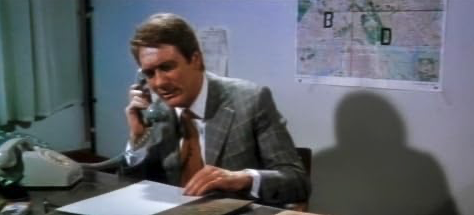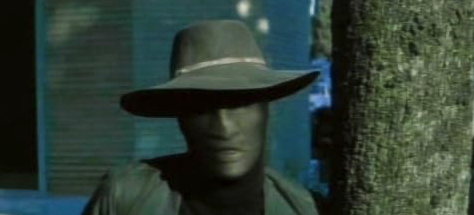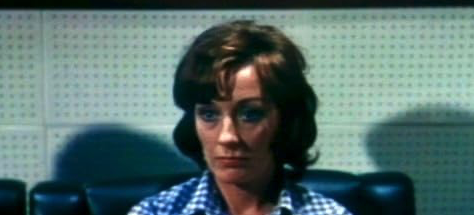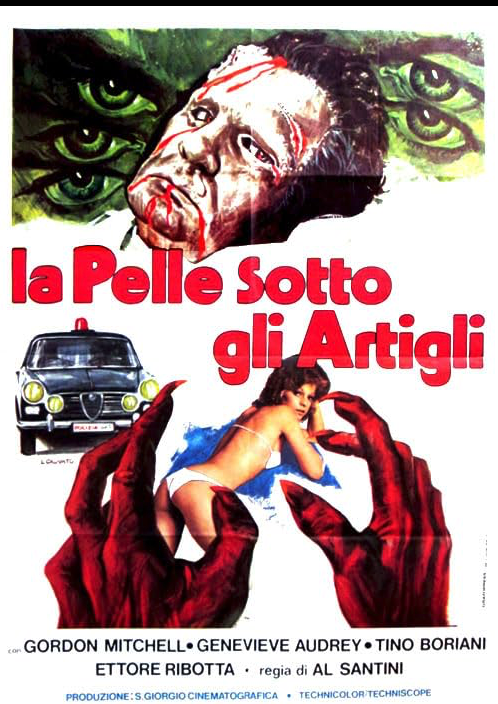‘I can’t believe a putrified corpse visits prostitutes and kills them.’
When a prostitute is murdered, the police find decomposing human skin under her fingernails and on her body. Suspicion falls on a handsome young doctor who works at an exclusive medical clinic…
Bizarre low-budget mashup of Giallo and science fiction from writer-director Alessandro Santini. American Gordon Mitchell heads the cast with support from Geneviève Audry and Tino Boriani.

Strange things are going bump in the night on the outskirts of Rome. A mysterious figure clad in black goes grave robbing by the light of the moon, and the body of murdered streetwalker Terri (Mirella Rossi) is discovered in the woods by a teenage couple. The policeman on the case, Commissioner Rinaldi (Ettore Ribotta), gets the surprise of his life when the medical examiner delivers his report. There’s decomposing human skin under the nails and on the body. Shortly afterwards, a mysterious man entrusts railway porter Oreste Belli (Renzo Borelli) with two suitcases but never arrives on the platform to catch his train. The luggage contains the remains of a dismembered woman, with the same strange traces on her corpse.
Refusing to believe any supernatural explanations, Ribotta finds a connection to young doctor Gianni Dani (Boriani), who works at the private medical clinic owned and managed by Professor Ernst Helmut (Mitchell). The older scientist is focused on organ transplantation, and his research has apparently progressed to a spot of brain-swapping between laboratory primates. Although fascinated by Mitchell’s experiments, Boriani is waylaid by his rapidly developing romantic attachment to colleague Dr Silvia Pieri (Audry), who returns his interest, even if she is reluctant to get too serious. When the second murder victim is identified as party girl Cinzia Rocci (Ada Pometti), Ribotta believes he has established a definite link with Boriani.

By the mid-1970s, the brief heyday of the Giallo was over, but this did not stop a small but steady stream of these horror thrillers hitting theatres in their native Italy. Most of these contained significant elements of the police procedural movies that had supplanted them in the crime genre at the box office, but other filmmakers chose to go in a somewhat different direction. In this instance, Santini seems to have been inspired by the kind of ‘mad scientist’ b-movies produced in the 1940s by second-string studio Columbia or lower-budgeted outfits such as Monogram or PRC. Unfortunately, the lack of any significant lab action or horror set pieces on display here was probably dictated by his own budgetary limitations.

As the more outlandish elements that drive the plot are kept almost entirely offscreen, what remains is a fairly standard thriller presentation that generally feels quite anaemic. Of course, events are more grounded without too much mad medico action, but if that was an artistic choice for credibility’s sake, that battle was already lost, given the story’s ridiculous premise. What largely remains then is the usual procession of men in suits talking in rooms intercut with far too much soppy stuff between Boriani and Audry, who likes to waffle on about being a modern woman but old-fashioned at the same time. Boriani, for his part, spends his time being alternately shy and socially awkward and behaving in ways that make him seem vaguely suspicious. These affectations include an aversion to bright lights and a tendency to wear sunglasses.
What is quite interesting is how the film has dated in certain respects. Mitchell’s scientist is primarily concerned with using organ transplants to save lives and extend the human lifespan, even towards immortality. His views and advocacy of an ‘organ bank’ for this purpose are presented as almost science-fiction and a little crazy. Indeed, Audry’s character, a medical professional herself, is horrified by the notion of mass transplants and even suggests that it would be like ‘creating a world of the living dead.’ Of course, half a century later, Mitchell’s contentions seem perfectly reasonable and even possibly within reach. At this point in the film, when Audry and Boriani debate the ethics of Mitchell’s research, there’s an impression that Santini may have something he wants to say about the subject. But then he cuts to a topless woman dancing in a lesbian strip club, so perhaps not!

Another weakness here is the somewhat disjointed feel. The film may have lost some footage as the VHS rip I viewed runs only 76 minutes, although that is the running time quoted by current sources. As it is, the climax is hopelessly rushed, and the final twist to the tale, no doubt intended as shocking, falls completely flat. Viewing a poor-quality transfer to VHS made during the home rental boom of the early 1980s precludes any lengthy evaluation of the project’s visual qualities. However, little in the way of the staging suggests any flair or invention was present. Many dialogue scenes are presented with very static, limited setups, and there’s a distinct lack of dynamism in the brief action scenes.
At first viewing, the film seems to disintegrate into complete confusion in the second act with one event following another with no rhyme, reason or logic. Ribotta and his assistant discuss one character as a possible suspect when they know that he’s already dead. Pometti’s friends worry about her disappearance after they’ve talked with Ribotta about her murder. Audry and Boriani take a romantic walk on the beach after returning to the city from their seaside weekend getaway. A rewatch confirms that Santini’s film belongs to a very exclusive club that, to my knowledge, only has two other members: Alfonso Brescia’s wretched space opera ‘Star Odyssey/Sette Uomini D’Oro Nello Spazio (1979) and ‘Blood’ (1974), Staten Island auteur Andy Milligan’s no-budget tribute to the Universal monsters. These are films with middle reels that have been transferred to tape in the wrong order! In the case of this example, if you take the footage that runs from around the 30 to the 45-minute mark on the print I saw and swap it around with the following 15 minutes, the scenes do form a logical narrative. It doesn’t turn it into a good movie, but it sure helps!

Santini’s list of filmmaking credits is relatively brief, although he seems to have spent a significant amount of time working in the industry. A lone credit as a producer was followed by half a dozen films as a production manager from 1956 to 1966, finishing with the obscure Spaghetti Western ‘Kill or Be Killed/Uccidi o muori’ (1966). By then, he had already dipped a toe in the writing process with a co-credit on horror film ‘The Seventh Grave/La settima tomba’ (1965). He also penned his directorial debut, the offbeat, semi-Giallo ‘Questa libertà di avere… le ali bagnate (This Freedom to have Wet Wings) (1971), the only other project where he fulfilled both roles. Aside from that, he has directorial credits for the poorly-regarded Spaghetti Western ‘Beyond the Frontiers of Hate/Al di là dell’odio’ (1972) and ‘Una forca per 3 vigliacchi’ (1979), a film so obscure that almost no information on it seems to exist.
A wacky plot like this may promise some entertainment value, but there’s little to be had from these results.

